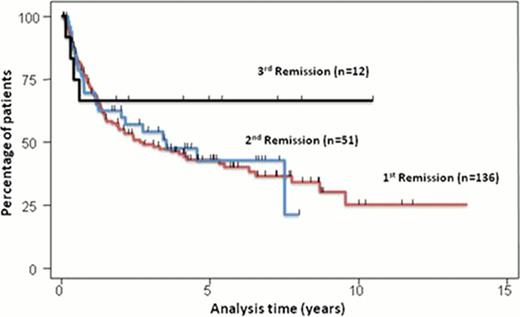Abstract
The clinical course of patients with follicular lymphoma (FL) in the pre-rituximab era was described by Johnson et al in 1995. It was characterized by a pattern of multiple relapses with progressively shorter durations of response and survival after each recurrence. The aim of this study was to describe the effect of recent therapeutic advances on the pattern of relapse in patients with FL.
For the purpose of this study, we arbitrarily defined the rituximab era as starting in 1997, as this is when an anti-CD20 monoclonal antibody was first used in our institution to treat patients with FL. Hence, between 1997 and 2007, 177 patients (49% female; median age: 56 years, range 25–89) were consecutively diagnosed with grade 1–3a FL and constitute the study group. Sixty-eight percent of the patients had stage III-IV at diagnosis and the distribution according to the FLIPI in 124 assessable patients was as follows: low-risk, 45%; intermediate-risk, 27%, and high-risk, 28%. We analyzed the duration of remission from best response, relapse and response rates, in addition to overall survival (OS) and progression free survival (PFS). Survival analysis and duration of remission was performed by the Kaplan-Meier method and the Cox-regression test was used to test for significant associations where appropriate.
Eighty-three patients were managed expectantly at diagnosis, whereas 94 received immediate treatment (41, chlorambucil with/without rituximab; 24, CHOP with/without rituximab; 16, radiotherapy; 10, fludarabine-based, and 3, single agent rituximab). After a median follow-up of 7.3 years (range: 1.2–14), 27 patients have never required treatment. High-dose therapy with autologous stem cell rescue (HDT-ASCR) was performed to consolidate response in 6 patients in first remission, in 15 at second remission and 1 in third remission. Two patients received an allogeneic transplant in second and third remission, respectively. Ninety-six patients received rituximab at some point as part of their treatment (42 patients as part of the initial treatment and 54 as part of subsequent treatments) while 81 patients have never received rituximab. The 5-year OS and PFS for the whole group were 78% (95%CI: 71 – 83) and 38% (95%CI: 31– 46), respectively. The response rate (CR + PR) at presentation, at first relapse and at second relapse were 91%, 83%, and 75%, respectively. The median duration of remission from best response at presentation was 2.8 years, whereas it was 3.5 years at first relapse and has not been reached at second relapse (figure). The median survival from best response at presentation, at first relapse and at second relapse were 12 years, 10 years and not reached, respectively. The median duration of first response in 42 patients that received rituximab as part of the 1st treatment has not been reached, whilst it was 1.5 years for patients that received rituximab not as part of the initial treatment but subsequently (p<0.001). In contrast, there were no significant differences in OS according to the timing of treatment with rituximab (p=0.94).
In contrast with the previous description of the clinical course in the pre-rituximab era, we did not observe a progressive substantial shortening of the response duration and survival with each subsequent relapse. This demonstrates that the introduction of new therapeutic options impacts not only on the outcome of patients but can also alter the clinical course of the disease.
Gribben:Celgene: Honoraria; Roche: Honoraria; Pharmacyclics: Honoraria; GSK: Honoraria; Mundipharma: Honoraria; Gilead: Honoraria.

This icon denotes a clinically relevant abstract
Author notes
Asterisk with author names denotes non-ASH members.



This feature is available to Subscribers Only
Sign In or Create an Account Close Modal